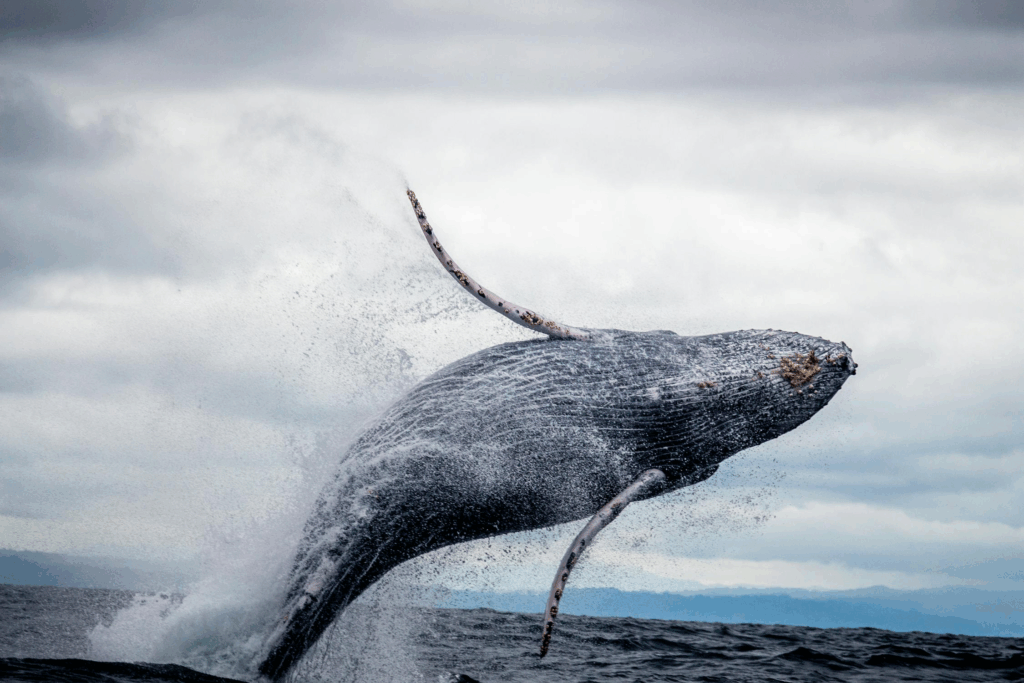What Are Hundreds of Humpback Whales Doing Off the South African Coast? No One Knows.
Something strange is stirring in the ocean depths—and it has marine scientists both baffled and captivated. Off the coast of South Africa, humpback whales—creatures typically seen alone or in small groups—are suddenly forming vast congregations, sometimes 200 strong.
These massive gatherings, dubbed “super-pods,” are not only unprecedented in scale, but they’re also showing up in unexpected waters and seasons.
It’s behavior no one predicted—and it raises one unsettling question: What are the whales responding to?

The Ocean’s Odd Assembly: A Super-Pod of Mysteries
Historically, seeing more than a dozen humpbacks together was noteworthy. These giants are usually loners, preferring solitude or small company as they migrate thousands of miles between polar feeding grounds and equatorial breeding zones. But these recent sightings—clusters of young whales feeding together in dense groups—go against the grain of everything researchers thought they understood.
Even stranger? This isn’t the time or place humpbacks should be feeding at all.
Instead of Antarctica, where they typically fuel up for the long journey north, these whales are lingering off the South African coast—socializing, feeding, and perhaps doing something else entirely. The phenomenon was so unexpected that scientists initially questioned their own data. But the evidence is real and has since been published in PLOS ONE, raising more questions than answers.
Why Are They Here—and Why Now?
One potential explanation is food—lots of it. Super-pods may indicate a sudden spike in prey abundance: krill, plankton, and small fish capable of feeding hundreds of whales. And yes, while humpbacks are known for their haunting underwater songs, they are also efficient predators with surprisingly complex tactics.
One such tactic? Bubble-net feeding—a learned, cooperative hunting strategy where a group of whales encircles fish with rising columns of bubbles. Then, in a perfectly timed surge, they lunge upward, mouths agape, swallowing thousands of fish in one coordinated gulp.
Not all whales know how to bubble-net. It’s a behavior passed from whale to whale, not something hardwired into their instincts. It’s one of many signs that there may be more intelligence and culture in the ocean than we’re ready to accept.
Is Something Bigger at Play?
Could this mass gathering be a consequence of global shifts—warming oceans, changing migration routes, or even deep-sea food chain collapse?
Some speculate that what we’re witnessing is a behavioral adaptation to climate change. Others wonder if we’re finally seeing the rebound of a species once brought to the brink of extinction. After all, humpback populations have been recovering steadily since international protections were put in place in the 1990s. Maybe whales were always this sociable—and it’s only now, as their numbers return, that we’re seeing what’s been hidden for decades.
Another theory? Maybe they’re moving into areas where human observation is more likely—close to shipping lanes and shorelines, where sonar, drones, and cameras catch moments that would otherwise vanish into the deep.
Are the Whales Trying to Tell Us Something?
Of course, there’s a poetic theory floating around too: what if the whales know something we don’t?
Perhaps these are not just feeding frenzies but gatherings of purpose—signals of disruption beneath the surface, or even rituals we have no way of comprehending. Are they mourning? Celebrating? Warning?
Or maybe they’re just adapting, surviving, and doing what animals have always done: responding to a world that changes faster than science can explain.
Conclusion: The Ocean Still Holds Its Secrets
Whatever the reason behind these awe-inspiring super-pods, one thing is clear—something has shifted in the way humpbacks interact with each other and their environment. Whether driven by rebounding populations, new food sources, or some uncharted behavioral evolution, these gatherings remind us just how little we truly understand about life beneath the waves.
As researchers scramble for answers, the rest of us can only marvel. Perhaps the whales are not signaling disaster—but resilience. Perhaps they are not the last to leave—but the first to adapt.
Until we know more, all we can do is observe, protect, and remain open to the idea that some messages from the deep aren’t meant to be decoded—only respected.
